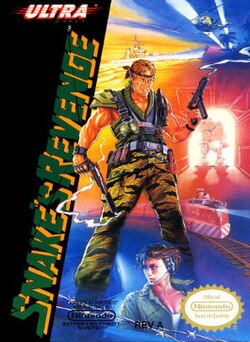
Metal Gear Solid is an action-adventure stealth video game developed and published by Konami for the PlayStation in 1998. It was directed, produced, and written by Hideo Kojima, and follows the MSX2 video games Metal Gear and Metal Gear 2: Solid Snake, which Kojima also worked on. It was unveiled at the 1996 Tokyo Game Show and then demonstrated at trade shows including the 1997 Electronic Entertainment Expo; its Japanese release was originally planned for late 1997, before being delayed to 1998.
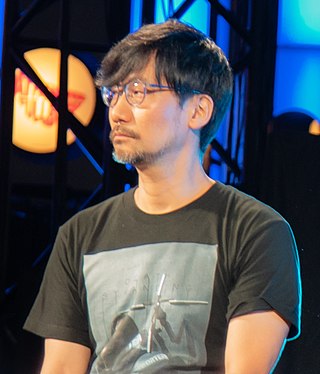
Hideo Kojima is a Japanese video game designer. He is regarded as an auteur of video games. He developed a strong passion for film and literature during his childhood and adolescence. In 1986, he was hired by Konami, for which he designed and wrote Metal Gear (1987) for the MSX2, a game that laid the foundations for stealth games and the Metal Gear series, his best known and most appreciated works. At Konami, he also produced the Zone of the Enders series, as well as wrote and designed Snatcher (1988) and Policenauts (1994), graphic adventure games regarded for their cinematic presentation.

Solid Snake is a fictional character from the Metal Gear series created by Hideo Kojima and developed and published by Konami, appearing as the main protagonist in many of the games of the series. He is depicted as a former Green Beret and highly skilled special operations soldier engaged in solo stealth and espionage missions who is often tasked with destroying models of the bipedal nuclear weapon-armed mecha known as Metal Gear. Controlled by the player, he must act alone, supported via radio by commanding officers and specialists. While his first appearances in the original Metal Gear games were references to Hollywood films, the Metal Gear Solid series has given a consistent design by artist Yoji Shinkawa alongside an established personality while also exploring his relationship with his mentor and father.

Metal Gear is a franchise of stealth games created by Hideo Kojima. Developed and published by Konami, the first game, Metal Gear, was released in 1987 for MSX home computers. The player often takes control of a special forces operative, who is assigned the task of finding the titular superweapon, "Metal Gear", a bipedal walking tank with the ability to launch nuclear weapons.

Metal Gear 2: Solid Snake is a 1990 action-adventure stealth video game developed and published by Konami for the MSX2 computer platform. It serves as a direct sequel to the MSX2 version of the original Metal Gear, written and designed by series's creator Hideo Kojima, who conceived the game in response to Snake's Revenge, a separately-produced sequel that was being developed at the time for the NES specifically for the North American and European markets. The MSX2 version of Solid Snake was only released in Japan, although Kojima would later direct another sequel titled Metal Gear Solid, which was released worldwide for the PlayStation in 1998 to critical acclaim. This later led to Solid Snake being re-released alongside the original Metal Gear as additional content in the Subsistence version of Metal Gear Solid 3 for the PlayStation 2 in 2005. It was also included in the HD remastered ports of Metal Gear Solid 3 released for PlayStation 3, PlayStation Vita, and Xbox 360, and was given a standalone re-release in Japan as a downloadable game for mobile phones and the Wii Virtual Console.

Metal Gear Solid 3: Snake Eater is a 2004 action-adventure stealth video game developed and published by Konami for the PlayStation 2. It was released in late 2004 in North America and Japan, and in early 2005 in Europe and Australia. It was the fifth Metal Gear game written and directed by Hideo Kojima and serves as a prequel to the entire Metal Gear series. An expanded edition, titled Metal Gear Solid 3: Subsistence, was released in Japan in late 2005, then in North America, Europe and Australia in 2006. A remastered version of the game, Metal Gear Solid 3: Snake Eater - HD Edition, was later included in the Metal Gear Solid HD Collection for the PlayStation 3, Xbox 360, and PlayStation Vita, while a reworked version, titled Metal Gear Solid: Snake Eater 3D, was released for the Nintendo 3DS in 2012. The HD Edition of the game was included on the Metal Gear Solid: Master Collection Vol. 1 compilation for Nintendo Switch, PlayStation 4, PlayStation 5, Windows, and Xbox Series X/S on October 24, 2023. The same year, Konami announced a remake, entitled Metal Gear Solid Delta: Snake Eater, set to release for PlayStation 5, Windows, and Xbox Series X/S in 2024.
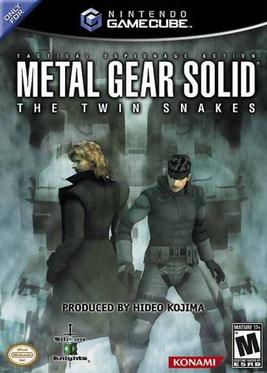
Metal Gear Solid: The Twin Snakes is a 2004 action-adventure stealth video game developed by Konami and Silicon Knights and published by Konami for the GameCube. Released in March, the game is a remake of Metal Gear Solid, originally developed by Konami Computer Entertainment Japan for the PlayStation in 1998.

Raiden, real name Jack, is a character and one of the protagonists of Konami's Metal Gear series of action-adventure stealth video games. Created by Hideo Kojima and designed by Yoji Shinkawa, Raiden was introduced in the series as the main player character of the 2001 game Metal Gear Solid 2: Sons of Liberty. In Metal Gear Solid 2, he appears to be a member of the U.S. special operations unit FOXHOUND and is participating in his first mission against terrorists. Despite coming across as a young rookie, he is later revealed to have been a child soldier in his native Liberia. Raiden also appears as a supporting character in the 2008 game Metal Gear Solid 4: Guns of the Patriots, in which he is assisting the series' main protagonist Solid Snake in his fight against Revolver Ocelot's forces. He is also the main character of the 2013 game Metal Gear Rising: Revengeance, in which he is dealing with his past and his present life as a combatant who faces enemies from private military companies.

Metal Gear Solid, released in Japan as Metal Gear: Ghost Babel, is a 2000 action-adventure stealth video game developed and published by Konami for the Game Boy Color. The game began development after Konami Computer Entertainment Japan were commissioned by Konami's European branch to develop a portable adaptation of their 1998 PlayStation game of the same title. However, the Game Boy Color version is not a port of the original PlayStation version, nor does it adapt the same story, but instead takes place in an alternative continuity set seven years after the events of the original Metal Gear (1987). Tose assisted on the development.
Big Boss is a video game character and the main protagonist/antagonist in the Metal Gear video game series created by Hideo Kojima and developed and published by Konami.

Penguin Adventure is a racing platform game released by Konami in 1986, and a sequel to 1983's Antarctic Adventure. The game marks the professional debut of game designer Hideo Kojima, who participated in the planning.
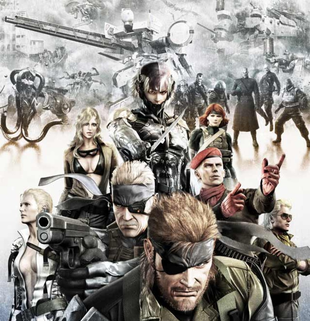
The Metal Gear franchise features a large number of characters created by Hideo Kojima and designed by Yoji Shinkawa. Its setting features several soldiers with supernatural powers provided by scientific advancements.

Metal Gear Solid: Portable Ops, officially abbreviated MPO, is a 2006 action-adventure stealth video game developed by Kojima Productions and published by Konami for the PlayStation Portable. The game was directed by Masahiro Yamamoto and written by Gakuto Mikumo, with series creator Hideo Kojima acting as producer.

Metal Gear Rising: Revengeance is a 2013 action-adventure game developed by PlatinumGames and published by Konami. It was released for the PlayStation 3 and Xbox 360 in February 2013, Windows and OS X in January and September 2014, and Nvidia Shield TV in January 2016.

Metal Gear is an action-adventure stealth video game developed and published by Konami for the MSX2. It was released for the system in Japan and parts of Europe in 1987. Considered the game to popularize the stealth game genre, it was the first video game to be fully developed by Hideo Kojima, who would go on to direct most of the games in the Metal Gear series. A reworked port of the game was released for the Famicom a few months later, which later saw release in international markets for the NES over the following two years; this version was developed without Kojima's involvement and features drastically altered level designs, among other changes. An emulated Famicom version came with the special edition of Metal Gear Solid: The Twin Snakes on GameCube. A more faithful port of the MSX2 version was later included in Metal Gear Solid 3: Subsistence for the PlayStation 2, as well as in the HD Edition of the same game released for the PlayStation 3, Xbox 360 and PlayStation Vita, with these newer ports featuring a revised translation and additional gameplay features. The MSX version was also released for Wii Virtual Console and PC.
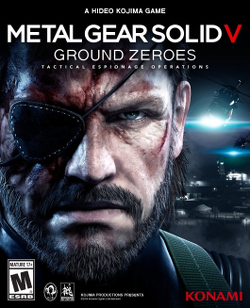
Metal Gear Solid V: Ground Zeroes is a 2014 action-adventure stealth video game developed by Kojima Productions and published by Konami. It is the eighth game in the Metal Gear series directed, written and designed by Hideo Kojima, and serves as a prologue to Metal Gear Solid V: The Phantom Pain, released the following year. Set in 1975, a few months after the events of Metal Gear Solid: Peace Walker, the story follows Snake as he infiltrates an American black site in Cuba called Camp Omega, attempting to rescue Cipher agent Paz Ortega Andrade and former Sandinista child soldier Ricardo "Chico" Valenciano Libre.
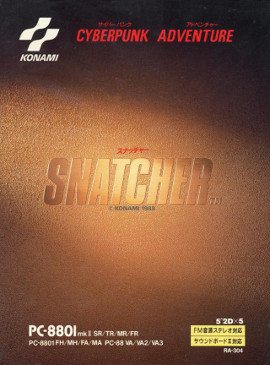
Snatcher is a cyberpunk graphic adventure game developed and published by Konami. It was written and designed by Hideo Kojima and first released in 1988 for the PC-8801 and MSX2 in Japan. Snatcher is set in a future East Asian metropolis where humanoid robots dubbed "Snatchers" have been discovered killing humans and replacing them in society. The game follows Gillian Seed, an amnesiac who joins an anti-Snatcher agency in search of his past. Gameplay takes place primarily through a menu-based interface through which the player can choose to examine items, search rooms, speak to characters, explore a semi-open world, and perform other actions.
Quiet is a fictional character from Konami's Metal Gear series. Created by Hideo Kojima, designed by Yoji Shinkawa, and based on and voiced by Stefanie Joosten, Quiet appears in the 2015 action-adventure stealth game, Metal Gear Solid V: The Phantom Pain. The character is a skilled assassin and sniper with superhuman abilities belonging to the covert strike force XOF, a rogue division of the American intelligence agency Cipher. Depending on the player's actions, she can be captured by Venom Snake and eventually used as a member of his Diamond Dogs mercenary group to participate in missions.
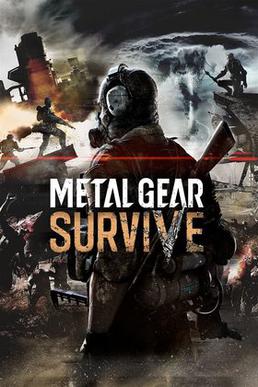
Metal Gear Survive is a 2018 survival game developed by Konami Digital Entertainment and published by Konami. The game was released for PlayStation 4, Windows, and Xbox One in February 2018. It is the first Metal Gear game to be developed following the series' creator Hideo Kojima's departure from Konami in late 2015, and the first since 1990's Snake's Revenge to be made without Kojima's input. Survive takes place between the events of Metal Gear Solid V: Ground Zeroes and Metal Gear Solid V: The Phantom Pain, and follows the Captain, an MSF soldier who enters a parallel dimension and establishes a local command center to unravel the mysteries of a strange virus that turns people into zombie-like creatures.
